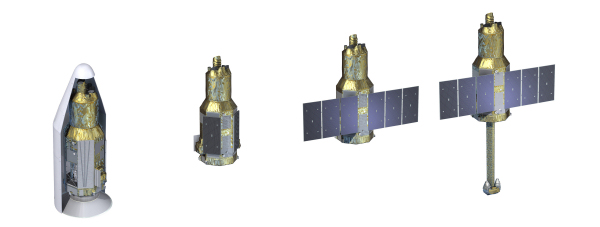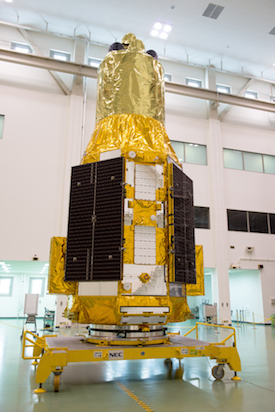Mission Operations
|
Note: Hitomi (formerly ASTRO-H) was a high-energy astrophysics space observatory, developed by the Japan Aerospace Exploration Agency (JAXA) in collaboration with institutions in Japan, the US, Canada, and Europe. It carried four instruments that together spanned the energy range 0.3-600 keV. The science goals of this mission included studying the dynamics of hot gas in galaxy clusters, the accretion of matter onto supermassive black holes at the cores of distant galaxies, and the acceleration of cosmic-ray particles up to very high energies. The mission was launched on 17 February 2016 at 08:45 UTC. On 28 April 2016, JAXA announced that they would discontinue operations of Hitomi as it was no longer possible to communicate with the satellite following an anomaly which appeared to have resulted in both solar array paddles having broken off from the spacecraft body. In June 2017, ESA announced that it will participate in Japan's X-ray Astronomy Recovery Mission (XARM), designed to recover the science of the Hitomi mission. |
Hitomi (known as ASTRO-H prior to launch) is a high-energy astrophysics space observatory, developed by the Japan Aerospace Exploration Agency (JAXA) in collaboration with institutions in Japan, the US, Canada, and Europe.
ESA contributed to Hitomi by funding some elements on the four science instruments, by providing three European scientists to serve as science advisors, and by contributing one scientist to the science operations team in Japan. In return for ESA's contribution, European scientists will be able to compete for about 8% of the observing time from this mission.
Launch and orbit
Hitomi was launched on 17 February 2016 on a Mitsubishi Heavy Industries H-IIA F30 rocket from the Yoshinobu Launch Complex at the Tanegashima Space Center, Japan. The rocket placed the satellite in a circular low-Earth orbit, with altitude of about 575 km and inclination of 31°.
 |
| Hitomi during and after launch. Credit: JAXA |
Operations
The mission will operate as an observatory, performing pointed observations of each selected astronomical source until reaching the total requested observing time, and then slewing to the next selected source. Typical observations will require from a few tens to a few hundred thousand seconds, equivalent to a fraction of a day to a few days for the expected observational efficiency. All instruments are co-aligned and are, in principle, able to observe the same region of the sky at the same time.
After the initial checking and performance verification phase, Hitomi will start to accept proposals from guest observers. These will be selected via peer review. The open observing time will start ten months after launch; the data obtained until then will be proprietary to the Hitomi team.
All data will be made publicly available after the proprietary period.
Announcements of Opportunity
In return for contributions from Europe, JAXA agreed that about 8% of the open observing time will be reserved for proposals from scientists in institutes located in the ESA Member States. The European proposals will first be peer-reviewed by an ESA-appointed Time Allocation Committee and the recommended proposals forwarded to JAXA for merging with those resulting from the parallel Japanese and US calls.
The Announcements of Opportunity for European observing time on Hitomi will be published by the ESA Directorate of Science, as is the case for other ESA or collaborative space science missions.
Operations Centres
 |
| Hitomi at the Tsukuba Space Center, Japan, in November 2015. Credit: JAXA |
The Science Operations Centre for Hitomi will be located at the Institute of Space and Astronautical Science (ISAS, Kanagawa Prefecture Japan), while the Mission Operation Centres will be located at ISAS, at the Tsukuba Space Center (Ibaraki Prefecture, Japan), and at the Uchinoura Space Center (Kagoshima Prefecture, Japan). Two of the antennas used by Hitomi are located at the Uchinoura Space Center.
NASA's Goddard Space Flight Center (GSFC) has responsibility to develop the processing pipeline (based on the output of a pre-pipeline developed and run by JAXA) and the interactive data analysis software to be utilized by end users, as well as to run a Guest Observer Facility in support of the American Guest Observers after launch. Data will be archived and distributed from GSFC and ISAS.
Support for European users of Hitomi is provided by two centres: the Science Operations Centre (SOC), located at European Space Astronomy Centre (ESAC) in Spain, and the European Science Support Centre (ESSC), located at the ISDC Data Centre for Astrophysics, University of Geneva, Switzerland.
The SOC will focus on supporting the European scientific community in the use of the allocated time for Hitomi, through handling annual calls for observing proposals and related activities, and by supporting users with data analysis, taking advantage of the expertise that scientists at ESAC have for calibration and cross-calibration of high-energy astronomy missions.
The tasks of the ESSC are focussed on supporting the European scientific community with respect to the utilisation of Hitomi, providing expert knowledge about the observatory, training European astronomers, and contributing to the validation of the scientific quality of the calibrations in the analysis software.
The ESSC will be staffed by scientists from the ISDC. Their role will be to provide information about Hitomi instruments, to support the preparation and distribution of documentation for the end users, to assist in testing data analysis software, and to analyse data of the in-flight calibration phase.
